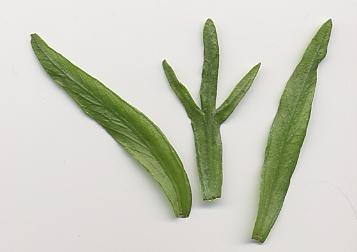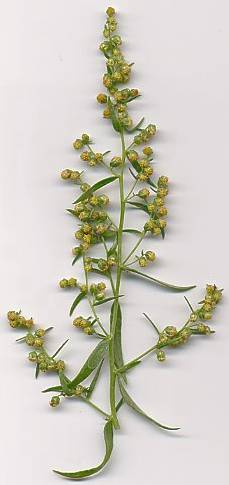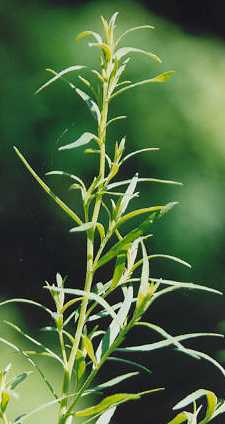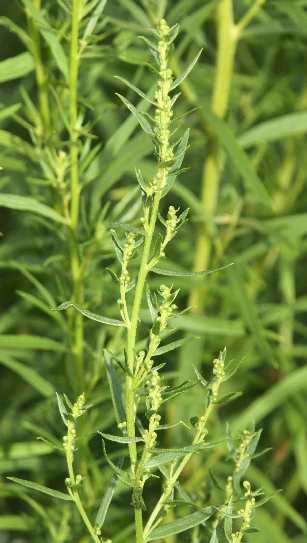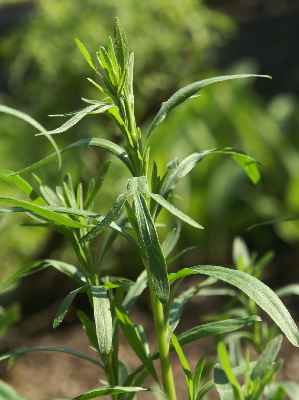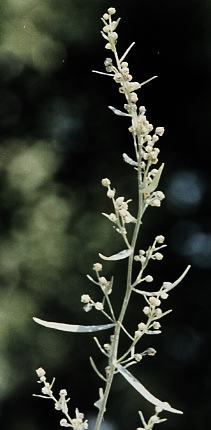
|
| French Tarragon with flowers |
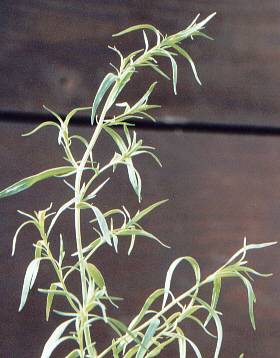
|
| French tarragon, sterile sprig |
Yet, in Southern Europe, particularly in France, tarragon is more popular; it is a component of the herbes de Provence (see lavender), of the fines herbes (see chives) and of French bouquet garni (see parsley). In French cuisine, tarragon is preferred as a fresh herb whenever possible.
Most Near Eastern cuisines make only sporadic use of tarragon, but Georgia (pretty much addicted to fresh herbs) is an exception. Georgian cooking uses a local variety of tarragon that has similar (but weaker) flavour as French tarragon, and it is often employed as a green garnish, and in some dishes as the main flavouring. An example is chakapuli [ჩაქაფული], a rather liquid stew of lamb chops with white wine and water, flavoured with ample chopped fresh tarragon that is simmered for some time with the meat. Usually, the dish acquires a fruity note by addition of unripe t’q’emali plums [ტყემალი], or the tkemali sauce made therefrom. In Georgia, there is also a carbonated softdrink with tarragon flavour (and an artificially green colour).
The rich and pleasant fragrance of German (or French) tarragon makes it a great addition to delicate European poultry dishes, herb sauces based on sour cream or mayonnaise or mushrooms. Tarragon is, however, most popular for salads; frequently, it is used to flavour vinegar (see dill) or olive oil used for salad dressings. For such purposes, tarragon can be combined with capers.
Tarragon is the characteristic flavouring for sauce béarnaise, a famous and justly praised recipe of classic French cuisine. For its preparation, molten butter is mixed with egg yolk and whisked over moderate heat until the sauce thickens. Sauce béarnaise owes its taste to white wine vinegar reduced to about one fifth of its original volume together with shallots (see onion), black pepper corns, tarragon and parsley leaves. The delicately flavoured sauce is mostly suggested to be served with fried, roasted or broiled meat, but it also goes well with boiled vegetables.
Sauce béarnaise may be considered as a more spicy variant of sauce hollandaise; the latter is made only from lemon juice, white wine, yolk and butter. Sauce hollandaise is typically served with boiled asparagus or artichokes. Sauces of this kind are called emulgated sauces, because they consist of fat drops finely dispersed in a water-like fluid (vinegar or lemon juice); such systems are referred to as emulsions by chemists. Another emulgated sauce is mayonnaise, made of vegetable oil, egg yolk and lemon juice (or another slightly acidic liquid).
For their high fat content, emulgated sauces can be flavoured by herbs and
spices efficiently, according to the cook’s phantasy. Obvious choices for a
herbed hollandaise (or a variant béarnaise) are chervil, dill and basil; less
obvious but very effective is lemon myrtle in
combination with some black pepper. A great,
yet not so well-known recipe is sauce maltaise (Maltese
sauce, named after the Mediterranean island of Malta), which has a distinct
fruity note from both orange juice and freshly
grated orange peel; a hint of nutmeg enhances the
aroma. Maltese sauce goes very well with fish and shellfish, but it is also
traditional for asparagus. An example for a
flavoured mayonnaise is aïoli (see garlic). Italian tuna sauce (salsa
tonnata, see capers) is another example of
an emulgated sauce, though much varied from the basic mayonnaise recipe.
